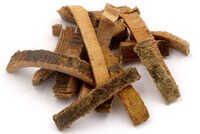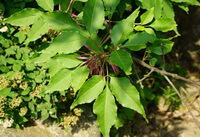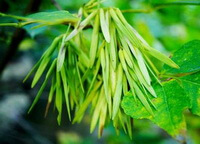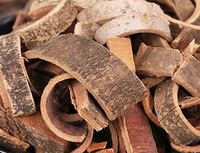Introduction of Qin Pi:Ash Bark or Cortex Fraxini.
-
 ✵The article gives records of the herb Ash Bark, its English name, Latin name, property and flavor, its botanical source four plant species, ①.Fraxinus rhynchophylla Hance., ②.Fraxinus szaboana Lingelsh., ③.Fraxinus chinensis Roxb., ④.Fraxinus stylosa Lingelsh., with a detailed introduction to the botanical features of these four plant species, the growth characteristics, and ecological environment of these four plant species, the features of the herb Ash Bark, its pharmacological actions, medicinal efficacy, and administration guide.
✵The article gives records of the herb Ash Bark, its English name, Latin name, property and flavor, its botanical source four plant species, ①.Fraxinus rhynchophylla Hance., ②.Fraxinus szaboana Lingelsh., ③.Fraxinus chinensis Roxb., ④.Fraxinus stylosa Lingelsh., with a detailed introduction to the botanical features of these four plant species, the growth characteristics, and ecological environment of these four plant species, the features of the herb Ash Bark, its pharmacological actions, medicinal efficacy, and administration guide.
- Cortex Fraxini(Ash Bark).
-
 Pin Yin Name: Qín Pí.
Pin Yin Name: Qín Pí.
English Name: Ash Bark.
Latin Name: Cortex Fraxini.
Property and flavor: cold, bitter, puckery.
Brief introduction: The Herb Cortex Fraxini is the dried branch bark or trunk bark of Fraxinus rhynchophylla Hance, Fraxinus chinensis Roxb., or Fraxinus stylosa Lingelsh., used for treating acute dysentery and inflammation of the eye. The herb is commonly known as Cortex Fraxini, Ash Bark, Qín Pí.
Botanical source: The herb Cortex Fraxini (Ash Bark) is the dried cortex or tree bark of species (1). Fraxinus rhynchophylla Hance., (2). Fraxinus szaboana Lingelsh., (3). Fraxinus chinensis Roxb., or (4). Fraxinus stylosa Lingelsh., they are plants of the Fraxinus L. genus, the Oleaceae family (olive family) of the Contortae order. These 4 commonly used species are introduced:(1).Fraxinus rhynchophylla Hance.
 Botanical description: Fraxinus rhynchophylla Hance is also known as Fraxinus chinensis Roxb.var.rhynchophylla (Hance) Hemsl., or Dà Yè Cén, Hua Qu Liu, or Big Leaf Fraxinus. Deciduous large trees, the tree grows up to 12~15 meters tall. Bark is taupe (dust-color, grayish brown), smooth, and lobed when turns old. Winter buds are broadly ovate, the apex is pointed, black brown, and glossy, inside is densely covered with brown curly fluff. The branch of the same year is primrose yellow (pale yellow), straight as a ramrod, and glabrous, the branch of last year is darkish brown (dust-color), and lenticels are scattered. Leaf rhachis has shallow grooves on its surface, has joints at the part where the leaflet grows, sometimes brown curve pubescence grows on the joints; 5~7 lobules, coriaceous, broadly ovate, obovate, or ovate-lanceolate, 3~11 cm long, 2~6 cm wide, lobule of vegetative branches is broad and big, terminal lobules are significantly bigger than the lateral lobules, 1 pair lobules at the lower side are the smallest, apex is acuminate, sharp-pointed or caudate (tail-pointed), the base is blunt, leaf edge is irregular coarsely serrate, serrate tip is slightly inflexed (curls inward), sometimes undulating, usually the lower part is subentire, white pilose grow on along the vein axils, gradually turn glabrous.
Botanical description: Fraxinus rhynchophylla Hance is also known as Fraxinus chinensis Roxb.var.rhynchophylla (Hance) Hemsl., or Dà Yè Cén, Hua Qu Liu, or Big Leaf Fraxinus. Deciduous large trees, the tree grows up to 12~15 meters tall. Bark is taupe (dust-color, grayish brown), smooth, and lobed when turns old. Winter buds are broadly ovate, the apex is pointed, black brown, and glossy, inside is densely covered with brown curly fluff. The branch of the same year is primrose yellow (pale yellow), straight as a ramrod, and glabrous, the branch of last year is darkish brown (dust-color), and lenticels are scattered. Leaf rhachis has shallow grooves on its surface, has joints at the part where the leaflet grows, sometimes brown curve pubescence grows on the joints; 5~7 lobules, coriaceous, broadly ovate, obovate, or ovate-lanceolate, 3~11 cm long, 2~6 cm wide, lobule of vegetative branches is broad and big, terminal lobules are significantly bigger than the lateral lobules, 1 pair lobules at the lower side are the smallest, apex is acuminate, sharp-pointed or caudate (tail-pointed), the base is blunt, leaf edge is irregular coarsely serrate, serrate tip is slightly inflexed (curls inward), sometimes undulating, usually the lower part is subentire, white pilose grow on along the vein axils, gradually turn glabrous.
Panicles are terminal or axillary at branch tip of the same year, about 10 cm long; flower bracts are long lanceolate, about 5 mm long, caducous; pedicels are about 5 mm long; male flowers and hermaphroditic flowers are dioecious; the calyx is shallow cyathiform (cotyloid), about 1 mm long, sepals are triangular and glabrous; corolla is absent; hermaphroditic flowers have 2 stamens, about 4 mm long; the pistil has short style, and stigma is deeply divaricated; male flowers have a small calyx, and filaments are thin, up to 3 mm long.
Samara is linear, nuts growing on the front end are about 1 cm long, slightly raised; with a persistent calyx. Its flowering period is from April to May, and the fruiting period is from September to October.
 Ecological environment: The tree grows on slopes, riverbanks, and roadsides, in areas below an elevation of 1,500 meters above sea level.
Ecological environment: The tree grows on slopes, riverbanks, and roadsides, in areas below an elevation of 1,500 meters above sea level.
Growth characteristics: The plant prefers a warm and humid climate and prefers sunlights. The soil requirements are not strict, it can grow in yellow soil, yellow-brown soil, and other soil. It is a light-loving tree species, suitable for the fields of deep soil layers, fertile soil with good drainage. The root system is developed and has a strong cold resistance, and can adapt to a wide range of temperatures. The annual average temperature is 5.5~14.4 °C (Celsius, or 41.9~57.92 degrees Fahrenheit), the highest temperature is 47.6 °C (Celsius, or 117.68 degrees Fahrenheit) in July, and the lowest temperature is over -40 °C (Celsius, or -40 degrees Fahrenheit) in January. But its ability to withstand atmospheric drought is poor. When the relative humidity is about 45% in July-August and the temperature is above 38 °C (Celsius, or 100.4 degrees Fahrenheit), the leaves will turn yellow or even fall off. It can still grow in soil when its salt content is less than 0.5%.
 Characters of herbs: The bark of branches is in reel shape (rolled tube-like) or groovelike, 10~60 cm long, and 1.5~3 mm thick. The outer surface is ash gray (grayish white), taupe brown (grayish brown) to black brown or patchy, flat or slightly coarse, with grayish-white dot-like lenticels and fine oblique wrinkles, and some has branch marks; the inner surface is yellowish white or brown, smooth. The texture of the herb is hard and brittle (crisp), the fracture surface is fibrous and yellowish-white. The herb is odorless, and it tastes bitter.
Characters of herbs: The bark of branches is in reel shape (rolled tube-like) or groovelike, 10~60 cm long, and 1.5~3 mm thick. The outer surface is ash gray (grayish white), taupe brown (grayish brown) to black brown or patchy, flat or slightly coarse, with grayish-white dot-like lenticels and fine oblique wrinkles, and some has branch marks; the inner surface is yellowish white or brown, smooth. The texture of the herb is hard and brittle (crisp), the fracture surface is fibrous and yellowish-white. The herb is odorless, and it tastes bitter.
The dried bark is a long strip piece block, with a thickness of 3~6 mm. The outer surface is taupe brown (grayish brown), with reddish-brown round or lalongate lenticels and frustose rills. The texture of the herb is firm and hard, and the fracture surface is strong fibrous.
Pharmacological actions: ①.Anti-inflammatory and analgesic effect; ②.Effect on urine volume and urate excretion.
Medicinal efficacy: Clear heat and drying dampness, clear the liver and improve the eyesight, relieve cough and asthma. It is indicated for dampness heat and diarrhea dysentery, morbid leukorrhea, red eyes and swelling pain; eyesores and nebula, lung heat and asthma cough.
Administration of Cortex Fraxini (Qín Pí):
Reference: Administration Guide of Cortex Fraxini (Qín Pí) TCM Books: ①.Internally:6~12 grams, Externally:proper amount,wash affected area with water decoction; ②.Internally:water decoction, 1.5~3 qian (about 4.5~9 grams), or prepare to pill,powder. Externally:wash with water decoction; ③.Internally:water decoction, 6~12 grams, Externally:proper amount,wash eyes with water decoction or drip eyes with liquid. (2).Fraxinus szaboana Lingelsh.
 Botanical description: Fraxinus szaboana Lingelsh is also known as Fraxinus chinensis Roxb.var.acuminata Lingelsh. (F.chinensis Roxb.var.acuminata Lingelsh.), F.caudata J.L.Wu, F.rhynchophylla Hance var.huashanensis J.L.Wu et Z.W.Xie., Jiān Yè Cén, Sharp Leaf Fraxinus,Jiān Yè Bái Là Shù (means pointed-leaf ash tree), Wěi Yè Cén, and so on. A deciduous small tree, it grows up to 3~8 meters high; bark is gray. Winter bud is big, sharp conical, the outside is densely covered with tawny fuzz and white glandular hairs, the inside is densely covered with brown curly pilose. Twigs are yellow, glabrous, or covered with fine pubescence, gradually turning glabrous, lenticels are small and protuberant, brown, elliptic, and scattered. Pinnately compound leaves are 12~20 cm long; petioles are 3~5 cm long, the base is slightly enlarged, brown curly pubescences grow in tufts on it when the petiole is tender, soon fall off; Rhachis is relatively thin, slightly curved, the upper surface has narrow groove, groove edge is deep, the part with lobule is articular, covered with fine pilose; 3~7 lobules, hard chartaceous (papery), ovate-lanceolate, rarely obovate-lanceolate, 4.5~9 cm long, and 2~4 cm wide, apical lobule is usually larger, the apex is long acuminate to caudate (tail pointed), the base is cuneate to blunt, leaf margin is sharply serrate, the upper surface is glabrous, sometimes the sides of midrib and base on the undersurface is covered with pale yellow or white fluff, midrib concave on the upper surface, lateral veins are in 6~8 pairs, the upper surface is flat, the undersurface is protuberant or raised, veinlets are raised and netting; petiolules are 2~3 mm long, or subsessile.
Botanical description: Fraxinus szaboana Lingelsh is also known as Fraxinus chinensis Roxb.var.acuminata Lingelsh. (F.chinensis Roxb.var.acuminata Lingelsh.), F.caudata J.L.Wu, F.rhynchophylla Hance var.huashanensis J.L.Wu et Z.W.Xie., Jiān Yè Cén, Sharp Leaf Fraxinus,Jiān Yè Bái Là Shù (means pointed-leaf ash tree), Wěi Yè Cén, and so on. A deciduous small tree, it grows up to 3~8 meters high; bark is gray. Winter bud is big, sharp conical, the outside is densely covered with tawny fuzz and white glandular hairs, the inside is densely covered with brown curly pilose. Twigs are yellow, glabrous, or covered with fine pubescence, gradually turning glabrous, lenticels are small and protuberant, brown, elliptic, and scattered. Pinnately compound leaves are 12~20 cm long; petioles are 3~5 cm long, the base is slightly enlarged, brown curly pubescences grow in tufts on it when the petiole is tender, soon fall off; Rhachis is relatively thin, slightly curved, the upper surface has narrow groove, groove edge is deep, the part with lobule is articular, covered with fine pilose; 3~7 lobules, hard chartaceous (papery), ovate-lanceolate, rarely obovate-lanceolate, 4.5~9 cm long, and 2~4 cm wide, apical lobule is usually larger, the apex is long acuminate to caudate (tail pointed), the base is cuneate to blunt, leaf margin is sharply serrate, the upper surface is glabrous, sometimes the sides of midrib and base on the undersurface is covered with pale yellow or white fluff, midrib concave on the upper surface, lateral veins are in 6~8 pairs, the upper surface is flat, the undersurface is protuberant or raised, veinlets are raised and netting; petiolules are 2~3 mm long, or subsessile.
Panicles are terminal or axillary and grow at the branch tip, 5~8 cm long; peduncles are 1.5~2 cm long, sometimes branch base has foliate (leaf-like) bracts, covered with sparse and scattering pilose or squarrose hairs, lenticels are scattered, inconspicuous; male flowers and hermaphroditic flowers are dioecious; the calyx is cyathiform (cotyloid), about 1.5 mm long, calyx teeth have triangular pointed apex; corolla is absent; style is shorter, stigma is bifurcated.
Samara is spatulate (spoon-shaped), 3~3.5 cm long, about 5 mm wide, the middle-upper part is widest, the apex is obtuse, the base is narrowing, wings are decurrent and extend to the middle of the nut, the nut is about 1.2 cm long, raised, veins edge is slender straight; calyx teeth of the persistent calyx is orderly, distanced from the base of the nut. Its flowering period is from April to May, and the fruiting period is from July to September.
 This species is distinct from Fraxinus rhynchophylla Hance.: branchlets, rhachis, and lobules are covered with hairs on the undersurface. 3~7 lobules (leaflets), lobule apex is long acuminate to caudate, often has white pilose on midvein base of the undersurface. Flowers have no corolla, bloom at the same time as leaves; the calyx is cyathiform (cotyloid), distanced from the base of the nut.
This species is distinct from Fraxinus rhynchophylla Hance.: branchlets, rhachis, and lobules are covered with hairs on the undersurface. 3~7 lobules (leaflets), lobule apex is long acuminate to caudate, often has white pilose on midvein base of the undersurface. Flowers have no corolla, bloom at the same time as leaves; the calyx is cyathiform (cotyloid), distanced from the base of the nut.
Ecological environment: The tree grows in shaw (holt or miscellaneous wood forest) of mountain areas at an altitude over 1,000 meters above sea
